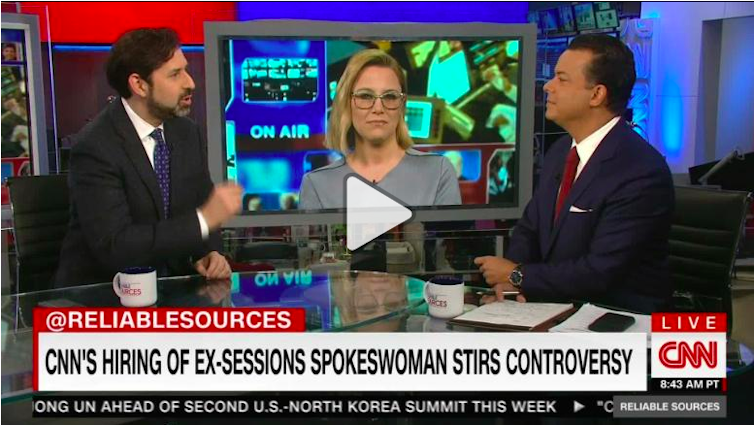Journalism needs to practice transparency in a different way to rebuild credibility
Trust in the news media is low. One way to regain that trust is better transparency, media experts say. But what does transparency mean? The field of organizational management may provide an answer.

Public trust in media continues to hover near all-time lows, driven by perceptions that the news industry is partisan and peddles inaccurate information (“fake news”), as well as ambivalence about news from social media.
According to a new Knight Foundation report on news media trust, transparency is a key factor in restoring trust.
Although media organizations promote the inherent value of transparency, they often do not explain what it means in practice.
In contrast, research in business organizations points to a clearer meaning and more specific practices of transparency that, if applied to journalism, could help journalists regain greater public trust.
What does transparency look like now?
There are many definitions of transparency in journalism.
The Society of Professional Journalists’ Code of Ethics defines transparency as “explaining one’s decisions to the public.” The recent report from media funder the Knight Foundation referred to transparency in journalism as “disclosing potential conflicts of interest and making additional reporting material available to readers.”
Both of these definitions suggest that transparency should constitute some sort of explanation to the consumer about the decision-making involved in the story.
These could be in the form of editorial disclosures that would explain, for example, if there was reader backlash to a story, why an editor felt a story was newsworthy, like in the case of The New York Times profiling a white nationalist.
Or they could be a longer “story behind the story,” published as a sidebar that explains both how and why a story was reported, such as Vice News did when covering ethnic cleansing in the Democratic Republic of Congo.

In practice, however, transparency in journalism is most often treated as a simple transaction between news organizations and their audience. Two common examples are journalists hyperlinking to original data sources that provide evidence for a story’s claims or nonprofit journalism organizations listing their sponsors.
But research in organizational management shows that while both the explanation and disclosure aspects of transparency are important for building trust, they are not enough and they need to be coordinated. In fact, by practicing only a partial version of transparency, journalism may well be harming itself and further damaging the public’s trust in its work.
Where transparency falls short
Organizational scholars Andrew Schnackenberg and Edward Tomlinson have proposed that transparency in organizations actually consists of three parts: disclosure (information is released in a timely manner), accuracy (information is correct), and clarity (information is understandable in context by the intended audience).
To understand how this definition of transparency could help media organizations, consider a recent example where the media reported on a controversy without the benefit of all three elements.
Prompted by the revelation that a Virginia governor’s 1984 yearbook page had a photo of a man in blackface on it, USA Today recently released a story about racism in college yearbooks.
Reporters reviewed over 900 yearbooks from 120 colleges and universities published over the past few decades for the story. The story that they wrote describes the pervasiveness of racist pictures in university yearbooks. (This article mentions a racist picture from our own university, Rochester Institute of Technology.)
USA Today also published a story behind the story, whose stated purpose was “to be as transparent as possible about what we found.” The supplemental article described the process by which photos were identified and analyzed.
The supplemental story states: “We found questionable photos virtually everywhere we looked – what amounted to a montage of everyday, casual bigotry memorialized among pages that captured daily life on campuses. Many of the photos did not have captions, making it difficult in some cases to determine what was going on. It is possible that some were part of a school play or had other explanations. But we built our report around images that had little or no ambiguity.”
This supplemental story seems to be an attempt at providing some clarity about the main story by helping the reader understand the motivation and process for writing the main story.
The supplemental story, however, does not provide full clarity. There are no images of the offending photographs in their larger context within the yearbooks, for example. Similarly, the supplemental story lacks disclosure; there is no comprehensive list of the 900 yearbooks or the 120 schools surveyed.

We believe that providing clarity (examples in context) and disclosure (a list of sources) would allow readers to independently verify the data in the story.
In this example, using Schanckenberg and Tomlinson’s definition of transparency could have led to better journalism – to a story that readers could trust more fully.
Competence, integrity, benevolence
Drawing on earlier research about trust, Schnackenberg and Tomlinson suggest that greater transparency can improve trustworthiness in organizations by helping to improve the public’s perception of their competence, integrity and benevolence. Those are the three key building blocks of trust.
What would this look like transferred from a traditional business to a news organization?
The news organization would report events in a way that is understandable and accurate and act according to its stated values, and its primary goal would be serving the public interest.
So when a news organization discloses – to the extent possible – its sources and own motivation for doing a story, it helps to build perceptions of integrity and benevolence. When it makes an effort to bring clarity and accuracy by explaining the overall context of a story, or when it provides insight into its own decision-making processes, it helps to build perceptions of competence and integrity.
How not to do transparency
To understand how the more nuanced definition of transparency borrowed from organizational business research can help news organizations build trust, consider the cable news network CNN. It recently hired Sarah Isgur Flores, a spokesperson for former Attorney General Jeff Sessions, to lead its 2020 election coverage.
As The New York Times noted, Flores was hired as a “political editor, not a pundit, and departing an administration in which the president routinely criticizes the news media, including CNN.”
CNN’s own media reporter, Brian Stelter, wrote about the hiring and the associated outcry about a political hack being placed in charge of supposedly objective reporting. His reporting verified the initial report from Politico, and Stelter wrote about Flores’ previous employment in his lead. It was an attempt to bring transparency to CNN’s actions.
But CNN executives would not speak for attribution with Stelter to defend the hiring, instead preferring to provide anonymous responses.
So, while Stelter attempted to tell the “story behind the story,” he was rebuffed by his own network.
This was confusing for audiences trying to understand Flores’ hiring as a political editor.
If CNN had accepted a definition and practice of transparency that included accuracy, disclosure and clarity, perhaps they could have given better thought to how this hire would be perceived and how they might publicly comment on it.
In the end, Flores announced that she will be a political analyst instead of an editor – a change in title she, not CNN, initiated.
When an important concept like transparency is only partially applied, it leads to something of a transparency trap. Media organizations may believe they are acting transparently, but incomplete attempts at transparency may damage credibility and thus do more harm than good.
The authors do not work for, consult, own shares in or receive funding from any company or organization that would benefit from this article, and have disclosed no relevant affiliations beyond their academic appointment.
Read These Next
Epstein’s victims deserve more attention than his ‘client list’
Powerful men connected to Jeffrey Epstein are named, dissected and speculated about. The survivors,…
Getting peace right: Why justice needs to be baked into ceasefire agreements – including Ukraine’s
Just war theory, a centuries-old field of ethics, deals with how and when to start conflicts. It can…
From civil disobedience to networked whistleblowing: What national security truth-tellers reveal in
Whistleblowers’ stories show how accountability is shifting from formal legal institutions to solidarity…






